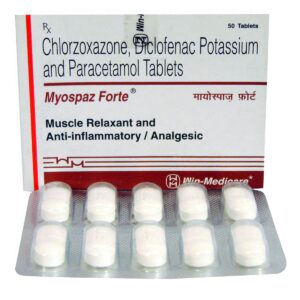CHLORZOXAZONE + DICLOFENAC + PARACETAMOL
Chlorzoxazone: Chlorzoxazone is a muscle relaxant drug that is used to relieve discomfort and pain caused by strains, sprains, or other muscle injuries. It is usually used in combination with rest, physical therapy, and other measures to alleviate muscle spasms.
The exact mechanism of action of chlorzoxazone is not fully understood. However, it is believed to work by depressing the central nervous system, specifically the spinal cord, which results in muscle relaxation. It may also have some direct effect on muscle fibers.
Chlorzoxazone is typically administered orally and the recommended dose for adults is 500 mg to 750 mg three to four times a day. The dosage may need to be adjusted based on individual response and tolerance.
Like most medications, chlorzoxazone can cause side effects. The most common side effects include drowsiness, dizziness, lightheadedness, headache, nausea, and upset stomach. These side effects are usually mild and transient.
In some cases, chlorzoxazone can cause more serious side effects, although these are rare. These potential side effects include allergic reactions, liver toxicity, jaundice, and blood disorders. If any of these occur, it is important to seek medical attention immediately.
It is important to note that chlorzoxazone may cause drowsiness, so it should not be used in combination with alcohol or other medications that can also cause drowsiness. Additionally, it is recommended to avoid activities that require mental alertness until the individual knows how they respond to the medication.
As with any medication, it is essential to follow the prescribed dosage and consult with a healthcare professional for personalized advice and guidance.
Diclofenac: Diclofenac is a nonsteroidal anti-inflammatory drug (NSAID) commonly used for its analgesic and anti-inflammatory properties. It is available in various forms such as tablets, capsules, gels, and patches.
This drug is primarily used to relieve pain and reduce inflammation associated with conditions like rheumatoid arthritis, osteoarthritis, ankylosing spondylitis, and postoperative pain. It is also sometimes used to treat migraines and menstrual pain.
The mechanism of action of diclofenac involves inhibiting the synthesis of prostaglandins, which are molecules involved in the inflammatory response. By blocking the action of cyclooxygenase enzymes, diclofenac reduces the production of prostaglandins, resulting in pain relief and decreased inflammation.
The dosage of diclofenac depends on the condition being treated and the formulation used. For oral tablets or capsules, the typical dose ranges from 25 mg to 50 mg taken two to three times daily. The maximum daily dose should not exceed 150 mg. The extended-release tablets or capsules are usually taken once daily, with doses ranging from 75 mg to 100 mg.
Topical diclofenac gel or patches are applied directly to the affected area. The recommended dose is applying 2-4 grams of gel up to four times a day. Patches may be applied to the affected area for up to 12 hours per day.
Although diclofenac is generally well-tolerated, it can have some side effects. Common side effects include stomach upset, nausea, diarrhea, dizziness, headache, and skin rash. In rare cases, there may be more serious side effects such as liver or kidney problems, heart-related issues, gastrointestinal bleeding, and allergic reactions. It is important to inform your healthcare provider if you experience any unusual symptoms while taking diclofenac.
As with any medication, diclofenac should be used under the guidance of a healthcare professional. It may interact with other medications, and the risk of side effects may be higher in certain individuals, such as those with a history of ulcers or heart disease.
Paracetamol: Paracetamol, also known as acetaminophen, is a commonly used medication for the management of pain and fever. It belongs to the class of drugs called analgesics (pain relievers) and antipyretics (fever reducers). Paracetamol is available over-the-counter and is widely used in various forms, including tablets, capsules, and liquid suspensions.
Paracetamol’s mechanism of action is not fully understood. It is believed to work primarily by inhibiting the synthesis of prostaglandins in the central nervous system, which helps to reduce pain and fever. Unlike nonsteroidal anti-inflammatory drugs (NSAIDs), paracetamol has minimal anti-inflammatory effects.
The typical adult dose of paracetamol is 500-1000 mg every 4-6 hours as needed, to a maximum of 4 grams (4000 mg) per day. The recommended pediatric dosages are based on weight and age, and it is important to follow the instructions provided by the healthcare professional or stated on the packaging.
Paracetamol is generally well-tolerated when used at recommended doses. However, it can cause some side effects, although they are rare. The most common side effects include mild stomach upset, nausea, and skin rash. In rare cases, it may cause liver damage, especially when taken in excess or in combination with alcohol. It is important to be cautious when using paracetamol in patients with liver disease or those who consume alcohol regularly.
In conclusion, paracetamol is a widely used analgesic and antipyretic medication. It is effective in reducing pain and fever but has minimal anti-inflammatory effects. It is generally safe when used at recommended doses, but it is important to be cautious of potential liver damage when exceeding the maximum daily dose or combining it with alcohol. It is advisable to consult a healthcare professional for appropriate dosing instructions and to discuss any potential concerns or underlying health conditions.

